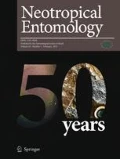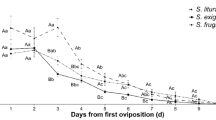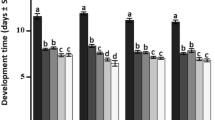Abstract
Telenomus remus Nixon is a promising biocontrol agent as an egg parasitoid of Spodoptera spp., but the lack of information on the host–parasitoid interactions in this system precludes its applied use in agriculture. Therefore, we studied the parasitism capacity of T. remus on eggs of Spodoptera cosmioides (Walker), Spodoptera eridania (Cramer), and Spodoptera frugiperda (Smith) in a range of temperatures (19, 22, 25, 28, 31, and 34 ± 1°C) under controlled conditions (70 ± 10% RH and 12 h photophase). Egg masses of Spodoptera spp. were offered to a single-mated T. remus female on a daily basis. More than 80% lifetime parasitism on eggs of S. cosmioides, S. frugiperda, and S. eridania was reached from 1 to 5, 1 to 7, and 1 to 9 days, respectively, at temperatures from 19 to 34°C. More than 80% parasitization was obtained at extreme temperatures for all hosts studied. Lifetime parasitization of S. frugiperda, S. cosmioides, and S. eridania was affected by temperature, with the lowest values for S. frugiperda (34°C) and S. cosmioides (19 and 34°C). Parasitization of S. eridania eggs was reduced around 18% at 28 and 31°C, but dropped more severely at 34°C. Parasitoid longevity was reduced as temperature increased. Thus, our data indicated that T. remus might be suitable as a biocontrol agent against S. eridania, S. cosmioides, and S. frugiperda in geographical areas that fit the temperature range studied here, even though T. remus parasitism was reduced at 34°C.



Similar content being viewed by others
References
Bai B, Luck RF, Forster L, Stephens B, Janssen JAM (1992) The effect of host size on quality attibutes of the egg parasitoid, Trichogramma pretiosum. Entomol Exp Appl 64:37–48
Bleicher E, Parra JRP (1990) Espécies de Trichogramma parasitoides de Alabamma argilacea. II. Tabela de vida de fertilidade e parasitismo de três populações. Pesq Agrop Bras 25:207–214
Bueno RCOF, Carneiro TR, Pratissoli D, Bueno AF, Fernandes OA (2008) Biology and thermal requirements of Telenomus remus reared on fall armyworm Spodoptera frugiperda eggs. Ciência Rural 38:1–6
Bueno RCOF, Carneiro TR, Bueno AF, Pratissoli D, Fernandes OA, Vieira SS (2010a) Parasitism capacity of Telenomus remus Nixon (Hymenoptera: Scelionidae) on Spodoptera frugiperda (Smith) (Lepidoptera: Noctuidae) eggs. Braz Arch Biol Technol 53:133–139
Bueno RCOF, Bueno AF, Pratissoli D, Parra JRP, Vieira SS, Oliveira LJ (2010b) Biological characteristics and parasitism capacity of Trichogramma pretiosum Riley (Hymenoptera, Trichogrammatidae) on eggs of Spodoptera frugiperda (J. E. Smith) (Lepidoptera, Noctuidae). Rev Bras Entomol 54:322–327
Bueno RCO, Parra JRP, Bueno AF (2012) Trichogramma pretiosum parasitism of Pseudoplusia includens and Anticarsia gemmatalis eggs at different temperatures. Biol Control 60:154–162
Burr IW, Foster LA (1972) A test for equality of variances. Mimeo series no. 282. University of Purdue, West Lafayette, 26p
Carmo EL, Bueno AF, Bueno RCOF (2010) Pesticide selectivity for the insect egg parasitoid Telenomus remus. BioControl 55:455–464
Cave RD (2000) Biology, ecology and use in pest management of Telenomus remus. Biocontrol 21:21–26
Cruz I, Figueiredo MLC, Oliveira CE, Vasconcelos CA (1999) Damage of Spodoptera frugiperda (Smith) in different maize genotypes cultivated in soil under three levels of aluminium saturation. Int J Pest Manag 45:293–296
Denis D, Pierre JS, van Baaren J, van Alphen JJM (2011) How temperature and habitat quality affect parasitoid lifetime reproductive success—a simulation study. Ecol Model 222:1604–1613
Desneux N, Decourtye A, Delpuech JM (2007) The sublethal effects of pesticides on beneficial arthropods. Annu Rev Entomol 52:81–106
Diez-Rodriguez GI, Omoto C (2001) Herança da resistência de Spodoptera frugiperda (J. E. Smith) (Lepidoptera: Noctuidae) à lambda-cialotrina. Neotrop Entomol 30:311–316
Ferrer F (2001) Biological control of agricultural insect in Venezuela: advances, achievements, and future perspectives. Biocontrol 22:67–74
Figueiredo MLC, Della Lucia TMC, Cruz I (1999) Controle integrado de Spodoptera frugiperda (Smith & Aboth) utilizando-se do parasitoide Telenomus remus Nixon. Pesq Agrop Bras 34:1975–1982
Figueiredo MLC, Della Lucia TMC, Cruz I (2002) Effect of Telenomus remus Nixon (Hymenoptera: Scelionidae) density on control of Spodoptera frugiperda (Smith) (Lepidoptera: Noctuidae) egg masses upon release in maize field. Rev Bras Milho e Sorgo 1:12–19
Frazer BD, McGregor RR (1992) Temperature-dependent survival and hatching rate of eggs of seven species of Coccinelidae. Can Entomol 124:305–312
Gerling D (1972) The developmental biology of Telenomus remus Nixon (Hym.: Scelionidae). Bul Entomol Res 61:385–488
Godfray HCJ (1994) Parasitoids: behavioural and evolutionary ecology. Princeton University Press, Princeton, New Jersey
Gupta M, Pawar AD (1985) Multiplicatin of Telenomus remus Nixon on Spodoptera litura (Fabricius) reared on artificial diet. J Adv Zool 6:13–17
Greene GL, Leppla NC, Dickerson WA (1976) Velvetbean caterpillar: a rearing procedure and artificial medium. J Econ Entomol 69:487–488
Hernández D, Diaz F (1995) Efecto de la edad del parasitoide Telenomus remus Nixon (Hymenoptera: Scelionidae) sobre su capacidad de ovipostura y proporción sexual de la descendencia. Bol Entomol Venez 10:161–166
Hernández D, Díaz F (1996) Efecto de La temperatura sobre El desarrollo de Telenomus remus Nixon (Hymenoptera: Scelionidae) parasiotide de Spodoptera frugiperda (Smith) (Lep.: Noctuidae). Bol Entomol Venez 11:149–153
Hernández D, Ferrer F, Linares B (1989) Introdución de Telenomus remus Nixon (Hym.: Scelionidae) para controlar Spodoptera frugiperda (Lep.: Noctuidae) en Yaritagua, Venezuela. Agron Trop 39:199–205
Higley LG, Pedigo LP, Ostlie KR (1986) Degray: a program for calculation degree-days, and assumptions behind the degree-day approach. Environ Entomol 15:999–1016
Huey RB, Berrigan D (2001) Temperature, demography, and ectothermic fitness. Amer Nat 158:204–210
Mills NJ, Kuhlmann U (2000) The relationship between egg load and fecundity among Trichogramma parasitoids. Ecol Entomol 25:315–324
Morales J, Gallardo JS, Vásquez C, Ríos Y (2000) Patrón de emergencia, longevidad, parasitismo y proporción sexual de Telenomus remus (Hymenoptera: Scelionidae) com relación al cogollero Del maíz. Bioagro 12:47–54
Nagoshi RN (2009) Can the amount of corn acreage predict fall armyworm (Lepidoptera: Noctuidae) infestation levels in nearby cotton? J Econ Entomol 102:210–218
Pak GA, Oatman ER (1982) Biology of Trichogramma brevicapillum. Entomol Exp Appl 32:61–67
Pexton JJ, Mayhew PJ (2002) Siblicide and life-history evaluation in parasitoids. Behav Ecol 13:690
Pizzol J, Pintureau B, Khoualdia O, Desneux N (2010) Temperature-dependent differences in biological traits between two strains of Trichogramma cacoeciae (Hymenoptera: Trichogrammatidae). J Pest Sci 83:447–452
Pogue GM (2002) A world revision of the genus Spodoptera Guenée (Lepidoptera: Noctuidae). Mem Amer Entomol Soc 43:1–202
Pomari AF, Bueno AF, Bueno RCOF, Menezes AO Jr (2012) Biological characteristics and thermal requirements of the biological control agent (Hymenoptera: Platygastridae) reared on eggs of different species of the genus (Lepidoptera: Noctuidae). Ann Entomol Soc Am 105:73–81
Reznik SYA, Vaghina NP (2006) Temperature effects on induction of parasitization by females of Trichogramma principium (Hymenoptera, Trichogrammatidae). Entomol Rev 86:133–138
Reznik SYA, Umarova TYA, Voinovich ND (2001) Long-term egg retention and parasitization in Trichogramma principium (Hymenoptera, Trichogrammatidae). J Appl Entomol 125:169–175
Santos GP, Cosenza GW, Albino JC (1980) Biologia de Spodoptera latifascia (Walk., 1856) (Lepidoptera: Noctuidae) sobre folhas de eucalipto. Rev Bras Entomol 24:153–155
SAS Institute (2001) User’s guide: statistics, version 8e. SAS Institute, Cary, NC
Shapiro SS, Wilk MB (1965) An analysis of variance test for normality. Biometrika 52:591–611
Silva AGA, Gonçalves CR, Galvão DM, Gonçalves AJL, Gonçalves J, Silva MM, Simoni L (1968) Quarto catálogo dos insetos que vivem nas plantas do Brasil: seus parasitos e predadores. Parte II, 1 tomo, Insetos, hospedeiros e inimigos naturais. Ministério da Agricultura, Rio de Janeiro, 622 p
Stark JD, Banks JE (2003) Population-level effects of pesticides and other toxicants on arthropods. Ann Rev Entomol 48:505–519
van Lenteren JC, Bueno VHP (2003) Augmentative biological control of arthropods in Latin America. Biocontrol 48:123–139
Visser B, Ellers J (2008) Lack of lipogenesis in parasitoids: a review of physiological mechanisms and evolutionary implications. J Ins Physiol 54:1315–1322
Volkoff AN, Daumal J (1994) Ovarian cycle in immature and adult stages of Trichogramma cacoeciae and T. brassicae (Hym. Trichogrammatidae). Entomophaga 39:303–312
Zalucki MP, Adamson D, Furlong MJ (2009) The future of IPM: whither or wither? Aust J Entomol 48:85–96
Acknowledgments
Thanks are also extended to Journal Experts Editor for the English revision and to Adair V. Carneiro, laboratory assistant, for helping conducting the trials. The authors would like to thank EMBRAPA, CAPES, and CNPq for the financial support that made this research possibleThis paper was approved for publication by the Editorial Board of Embrapa Soja.
Author information
Authors and Affiliations
Corresponding author
Additional information
Edited by Madelaine Venzon – EPAMIG
Rights and permissions
About this article
Cite this article
Pomari, A.F., Bueno, A.F., Bueno, R.C.O.F. et al. Telenomus remus Nixon Egg Parasitization of Three Species of Spodoptera Under Different Temperatures. Neotrop Entomol 42, 399–406 (2013). https://doi.org/10.1007/s13744-013-0138-0
Received:
Accepted:
Published:
Issue Date:
DOI: https://doi.org/10.1007/s13744-013-0138-0




